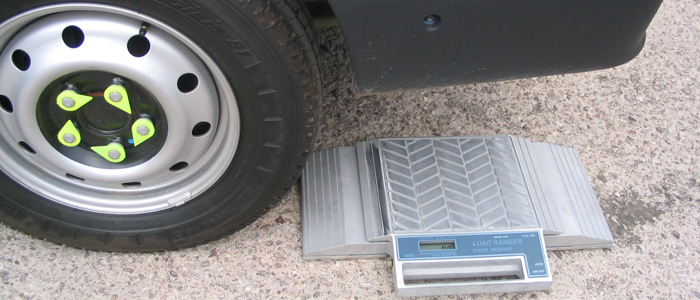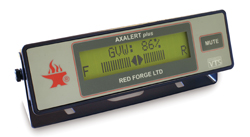Vehicle weight restrictions.
It’s all too easy to fall foul of the weight restrictions on vehicles. In this article Phil Bridge, Sales Office Manager of Red Forge Ltd, offer some good advice.

Life in the removals market is focussed around transport. A company who provides this service not only has to ensure that they have the right vehicles to carry the load, but that their drivers, being the day to day face of the company, are well trained, presentable and above all protected from all of the necessary red tape that accompanies this role. A fleet manager has many questions to answer: How many hours have my drivers done this week? How do I know where my drivers are? Are they capable of completing the tasks assigned to them in the time given? Is the job profitable? How do I know or trust the weight of what my customers are asking me to carry?
Fortunately, solutions exist for many of these problems. No-one wants to see another tragic accident that causes serious injury or death due to mistakes made when a driver is tired. Increased publicity and the advent of digital tachographs has tightened control and highlighted the safety aspects of working hours. In fact, very few people in the industry today can claim to be ignorant of the laws regarding the hours issue. This can only be seen as progress.
The introduction of telematics systems now gives the fleet manager a powerful tool to keep track of the location of a vehicle and many aspects of its daily life. From planning workloads and journey times, to keeping the supervisor in touch with the vehicle's current status, the technology is far more than just a 'spy in the cab'. Again, progress.
What about the weight issue? Under The Road Traffic Act 1972 and The Motor Vehicles (Construction and Use) Regulations 1978, it is a punishable offence to use or permit to use on the Public Highway a goods vehicle whose weight exceeds its plated gross weight or where the maximum plated axle weight is exceeded. The maximum plated weight includes the unladen vehicle and any payload added on. You would be amazed at how many people believe that a Transit van can carry 3.5 tonnes of payload!
Over-loading makes a vehicle less stable, can invalidate your insurance and increases the wear and tear on the tyres, on the suspension and on the road itself. It will also affect braking and steering. This increases maintenance costs for the upkeep of the fleet. From the opposite point of view, under-loading affects profitability and will mean additional trips and therefore costs that could be unnecessary. Often, despite the Gross Vehicle Weight being within regulations, an axle can become overloaded with no way for the driver to realise it.
Punishment is usually a fine, with a maximum of £5,000 per offence; this can mean that a 7.5T vehicle can potentially generate fines of up to £15,000 in a single case (one fine per axle, plus one for the gross). Repeat offenders may well see their Operators Licence taken away. The Road Traffic Act 1988 states that driving a dangerously over-loaded vehicle carries a maximum two years imprisonment. In the case of Corporate Manslaughter caused through an over-loaded vehicle, not only the driver but also the supervisors and even directors of a company can be held responsible, due to their ‘Duty of Care’ as per the Health and Safety at Work Act 1999. With all this legislation, the question remains: How well enforced are these laws?
According to its Effectiveness Report 2005/6, VOSA stopped nearly 75,000 vehicles for overloading in that year, and over a quarter of these were issued with prohibitions. The figures show that LCV's are often the worst offenders, with 38.7% of light vehicles prohibited when stopped. These figures can only show that VOSA are getting far more effective when it comes to spotting an over-loaded vehicle, and nobody is exempt from these inspections, especially when it comes to high profile markets such as the varying forms of haulage.
So what is the best way to avoid overloading? VOSA’s website gives many useful pieces of information and the Fleet safety forum at www.brake.org.uk has downloadable information which is useful for any fleet user. Ensure that the load is evenly distributed across the vehicle and that it is secured properly. The vehicle can easily be fitted with a system that gives a warning when the vehicle is overloaded. These systems have become commonplace within high risk markets such as construction and waste, and have now evolved with reversing camera link ups for easy viewing from the cab and to reduce dashboard ‘clutter’. Telematics system compatibility is also available, to send the information back to the depot remotely if so required.
As with almost any problem, the best way to avoid overloading is communication and education - speak with your drivers and ask their opinions. Ensure that they understand what the vehicle can carry and what it means if they ignore it. You are not only protecting their driving licences and the legal ability of the company to operate, you are protecting their lives and the lives of others.
 About Red Forge
About Red Forge
Red Forge is one of the market leading companies in the field of On-Board Weighing and Axle Load Indication.
Based in the Midlands and now in its 36th year, Red Forge continues to provide overloading solutions and advice to many large fleet users, including the utilities, refuse and haulage markets. Almost any vehicle can be catered for, as original equipment or retrofit, from small car derived vans through to articulated configurations, always with the correct solution for the customer’s requirement as the most important factor.
Anyone requiring more information on overloading or the ways to prevent it should contact Red Forge on 01527 526112 or www.redforge.co.uk.
Top photo: a vehicle about to be weighed on Red Forge's Axalert Plus display, below; Axalert Plus 2010 display.